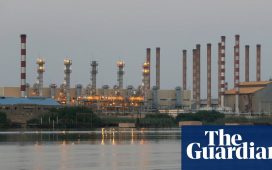A decade has elapsed since the Labour government published plans for a high-speed rail line between London and Birmingham, and later to Leeds and Manchester. It was a grand vision, enthusiastically adopted by the coalition, backed by northern leaders, but never embraced in Tory heartlands.
Indeed, for much of the Brexit wing of the party, HS2 has been an abbreviation almost as loathed as EU. Now their man is in Downing Street just as reports suggest the project might require another £30bn from taxpayers. With Boris Johnson promising a review, contracts paused and legislation for the northern section yet to appear, can Britain’s high-speed network ever become reality?
A peek behind the hoardings in north-west London offers a different perspective. Matthew Botelle, HS2 Ltd’s programme director for London, is used to this question: “My friends outside London ask if HS2 is happening. Well, they haven’t seen this.”
This is the vast, newly cleared expanse of Old Oak Common, the capital’s next great regeneration project, where HS2 meets Crossrail, and billions in land development will follow. Buildings, industrial units and – just last week – the last of the Great Western train depot have been bulldozed into an eye-opening void.
Seven sites in the area are now almost cleared. One, awaiting further excavation for Old Oak station’s enormous subterranean high-speed platforms, is a kilometre-long wedge of land, bigger than Hyde Park, where a few machines continue to break up the remaining demolished buildings.
In a few years, this is expected to be one of the UK’s busiest hubs, with 250,000 people passing through every day, speeding down from Britain’s largest cities. Old Oak Common will be an interchange station between HS2 and Crossrail, which will be known as the Elizabeth line.
In an adjacent lunar landscape of crushed rubble, tunnel boring machines will start their journey south-east to Euston. Other expanses have been cleared to hold spoil on its way out, and to store pre-cooked segments of tunnel on their way in.
In HS2 terminology, these are still “preparatory works” – the most advanced of the four main sites in London and Birmingham. Elsewhere, the reshaping of the Euston area continues apace: two office towers in front of the station are being pulled down, along with vacated council housing blocks. After the controversial destruction of St James’ Gardens, excavation of the old cemetery is progressing. Archaeologists now believe the number of skeletons they will have to relocate is lower than forecast.
Demolitions and clearance have also progressed at Birmingham’s Washwood Heath, which will house the first depot for the high-speed trains, to be commissioned next year. In the heart of the city, the Curzon Street site of the future Birmingham HS2 station awaits development – although a new hiatus emerged this month after HS2 Ltd revealed that its £435m invitation to tender to build the station attracted no bidders.

That is not HS2’s only hiccup. Sign-off on the major civil construction contracts has been delayed until the end of the year. And a large number of the 350,000 trees planted to date perished in last year’s hot spell, HS2 admits, with 2019’s toll unknown.
Are the prospects for the railway better than for the saplings? Deeper doubts have been sown by a letter from HS2’s chairman, Allan Cook, to the Department for Transport, leaked to the Financial Times. While HS2’s funding has officially remained unchanged at £55.7bn since 2015, Cook has reportedly revised estimates up to £70-85bn, partly blaming “poor ground conditions found during surveying work”.
Critics and whistleblowers have alleged for some time that the bill would escalate – even without the mismanagement of HS2 Ltd, which paid huge salaries to executives who departed before a spade was in the ground, and shelled out millions in unauthorised redundancy packages.
Lord Berkeley – a transport specialist who has produced costings that claim even the London-Birmingham phase could not be built within budget – has accused ministers of misleading parliament by sticking to the £55bn figure for so long. He told the House of Lords this month that HS2 would eventually prove “10 times worse” than Crossrail for overruns and delays.

There are certainly grounds for a review, which Johnson has promised. But critics should not expect too much: a report was downgraded to “a brief six-week study of the profiling of the spend” at his first prime minister’s questions. This will be run by Doug Oakervee, who led the Crossrail project while Johnson was London mayor, and is an established HS2 supporter.
New transport secretary Grant Shapps has consistently voted for the scheme and chairs the British Infrastructure Group of MPs pushing for new development, but the hiring of Andrew Gilligan, Johnson’s cycling sidekick at City Hall, as transport adviser puts a committed HS2 sceptic at the heart of government.
Other ideas include starting to build in the north, and prioritising Northern Powerhouse Rail – which Johnson hinted at on Saturday with his pledge to improve the Leeds-Manchester link. That need not augur ill for HS2; planners say creating fast links between northern cities depends on HS2 lines.
Looking out over the flattened land of Old Oak Common, Botelle is unfazed: “If you work in infrastructure, there is always a lot of surrounding talk. For something of the scale of HS2, it would be naive to think there wouldn’t be ongoing debate.”
Some critics say this site should be the London terminus, rather than Euston – saving some £8bn, according to Berkeley. That idea is frowned on by Botelle and HS2, but could prove a way for Johnson to rein in costs without skewering his own legacy: the development corporation behind Old Oak Common regeneration, with 25,500 new homes and 65,000 jobs, was set up by mayoral decree and chaired by Johnson himself.














